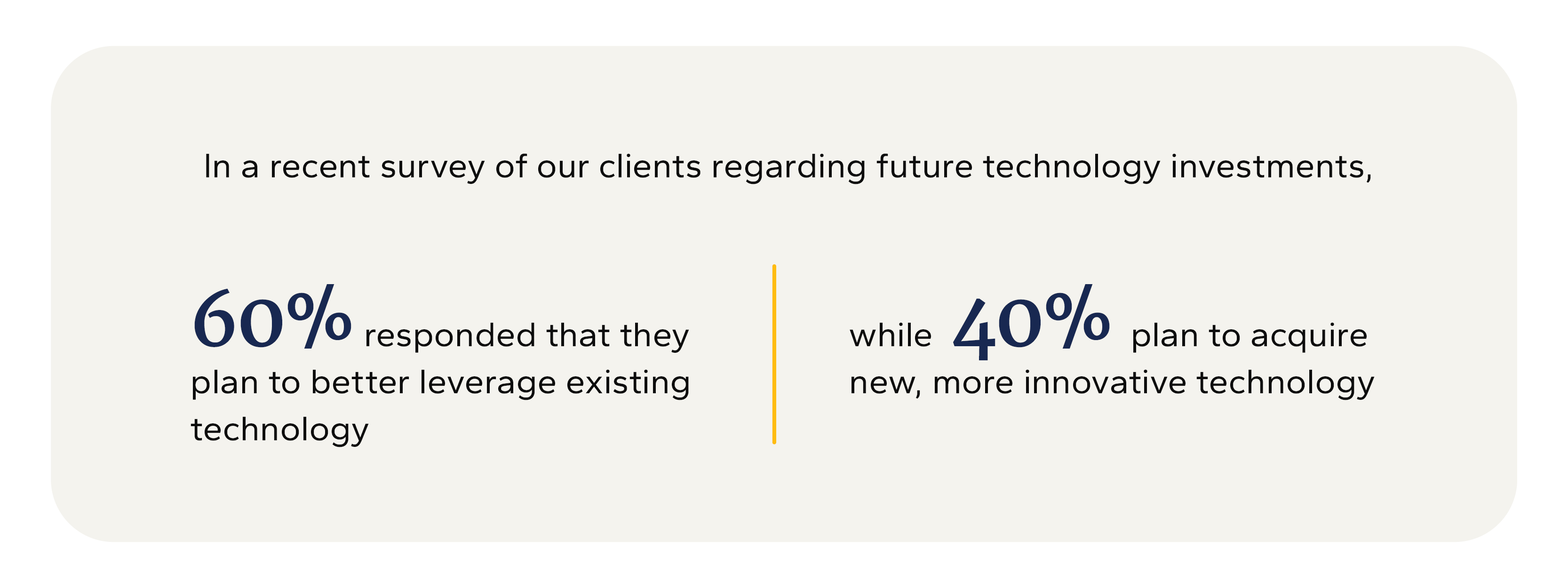Key Takeaways
- The two approaches to investing in technology are leveraging existing technology and investing in new technology.
- Any technology investment strategy should seek to align technology with the overall business strategy.
- Executive support and organization-wide communication creates trust and builds momentum.
Growth doesn’t come from standing still. In fact, nearly 80% of organizations need to adapt every 2-5 years in order to stay relevant.
The truth is agility means more than trying to solve challenges with new solutions. A strategic digital roadmap can help you create a high-impact technology investment strategy that meets overall business objectives.
The Two Approaches to Technology Investment
There are two technology investment strategies: either you already have all the technology you need but struggle to capitalize on it, or you have gaps in your current tech stack which need to be filled through new investments.

The direction you choose depends on the current challenges and long-term goals of your organization.
Leveraging Existing Technology
By aligning your existing technology with your business objectives and streamlining your business processes, you can maximize your efforts. Optimizing the technology you’ve already invested in supports organizational growth, creates long-term alignment, and maintains security.
Take a thorough inventory of all your technology, asking yourself:
- Are there any overlaps in the purpose or functionality of our tools?
- Are there any functions or capabilities in our current technology we are not taking advantage of?
- Are there any tools that we no longer need? (Remember, any cost savings from greater efficiency can be spent on future technology investments).
Investing in New Technologies
When legacy systems are no longer supported— or no longer support your growing organization — it’s time to invest in new technology. This is especially likely if you’re expanding, as your systems and processes will need to support that growth.
Consider the following:
- What information or tech stacks are stuck in silos?
- Are there any manual processes that could be performed more efficiently using technology?
- Are any departments using different tools to accomplish the same tasks?
- Listen in to hear our discussion on Defining a High-Impact Technology Investment Strategy.
Overcoming Roadblocks to Innovation
Developing a high-impact digital investment strategy is essential for the continued growth, but it isn’t without obstacles. Understanding and preparing for these roadblocks will make your digital initiatives run more smoothly and be more successful.
Lack of Leadership Support
Leadership support is critical when proposing an organization-wide change. To improve your odds of obtaining executive support, be prepared to explain the “why” behind the need. Data is key, so take the time to prepare a cost-benefit assessment to show the ROI and its impact on the bottom line.
Lack of Change Management
Without a well-coordinated implementation strategy, digital initiatives can be quickly derailed. Make sure you have a steering group committee with members from different key functions.
Only 34% of change initiatives are a success. Projects with change management are six times more likely to succeed.
In the pre-implementation phase, identify all end-users and poll them as to what their job pain points are, as well as what they like and don’t like. Use that information to create a new way to make their jobs easier. This action can underscore the positive impacts of the change while building the momentum you need to get wider acceptance and cooperation throughout your organization.
Lack of Transparency
A lack of information may lead people to believe the worst and become defensive. If someone has been running reports in a certain way their process changes, they may resist the shift. Being transparent about upcoming changes before they occur, explaining the “why” behind the change, and having empathy and compassion for those who resist will help maintain morale.
Organizational culture is a team effort and buy-in from leadership is just as important as that from employees.
Embarking on Your Digital Journey
While a patchwork approach to technology investment may suffice in the short term, it is not sustainable in the long run. Prioritizing quick fixes over long-term solutions, leads to the wrong investment or solving problems that don’t exist. It could leave you with a technical debt and insufficient funds to address future issues.
To understand where to go in your digital strategy, document the capabilities of your team members, business structure, and existing technology stack.
- Analyze your organization’s strengths and weaknesses.
- Evaluate team members’ skill sets and capabilities as they pertain to their roles. Is their department under- or overstaffed? Do staff have the necessary expertise? What is their willingness to change?
- Assess employees’ processes and the technology they use. What tasks must they perform manually? How efficient are these processes and systems?
- Determine the capabilities of the technology systems used today. What is missing to support your business objectives?
Once you have completed your assessments, collaborate with your leadership team to identify inefficiencies, gaps, threats, and opportunities before moving on to goal setting and strategizing.
To be sure you don’t interrupt a process that does work as it is, ask yourself:
- Is there a business need for the way it’s done today?
- What is the business value or customer value of doing it this way?
If there’s no need or value for the existing process, it’s a candidate for change.
Ultimately, building a digital future is an ongoing process that requires constant evaluation and adaptation. While it takes time and resources, a successful implementation will help you thrive in today’s landscape and prepare for tomorrow’s.
Leading Intentionally: How to Make Data-Driven Decisions

Strategy and Digital Future
Create a lasting digital future for your organization.
Who We Are
Eide Bailly is a CPA and business advisory firm helping our clients grow, thrive, and embrace opportunities and innovation.



